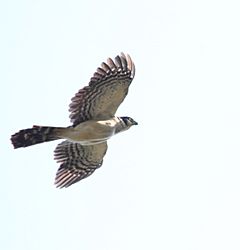Forest Falcon facts for kids
Quick facts for kids Forest falcons |
|
|---|---|
 |
|
| Collared Forest Falcon Micrastur semitorquatus |
|
| Scientific classification | |
| Kingdom: | |
| Phylum: | |
| Class: | |
| Order: | |
| Family: | |
| Subfamily: |
Polyborinae
|
| Genus: |
Micrastur
G.R. Gray, 1841
|
| Species | |
|
7 currently recognised:
|
|
Forest falcons are amazing birds of prey that live in the Americas. They belong to a group of birds called Micrastur, which is part of the larger falcon family. You can find them from Mexico in the north, through Central America, and across much of South America, reaching as far south as northern Argentina. Most forest falcons prefer to live in warm, wet tropical and subtropical forests. However, two common types, the collared and barred forest falcons, can also be found in drier or more open areas.
Contents
What Makes Forest Falcons Special?
Forest falcons are different from many other falcons. While most falcons are known for their incredible speed in open skies, forest falcons are built for agility. They are great at moving quickly through thick trees and dense forest cover.
Built for the Forest
These birds have special features that help them in their forest homes:
- They have short wings. This helps them fly easily between trees.
- They have long tails. A long tail acts like a rudder, helping them steer and turn sharply.
- They have incredibly sharp hearing. This helps them find prey hidden in the dense forest.
Even though they are often hard to see, you can usually hear their unique songs. Their calls are a common sound in the forests where they live.
How Do Forest Falcons Hunt?
Forest falcons are smart and flexible hunters. Their diet includes a mix of birds, small mammals, and reptiles. They often hunt in a clever way, similar to how a northern goshawk hunts.
Hunting Strategy
Here's how they typically hunt:
- A forest falcon will find a hidden spot on a branch.
- It waits patiently for an animal to pass by below.
- Once prey is spotted, the falcon strikes quickly. It flies out in a short, fast chase to catch its meal.
Some species, like the collared forest falcon, have longer legs. This helps them catch prey on the ground too, showing how adaptable they are.
Discovering New Species
Scientists are always learning new things about animals. In 2002, a brand new species of forest falcon was discovered!
The Cryptic Forest Falcon
- This new bird was found in the Atlantic Forest and the southeastern Amazon rainforest in Brazil.
- Later, it was also confirmed to live in nearby parts of Bolivia.
- It was named Micrastur mintoni, or the cryptic forest falcon.
- It's called "cryptic" because it looks very similar to another species, M. gilvicollis, making it hard to tell them apart at first glance.

